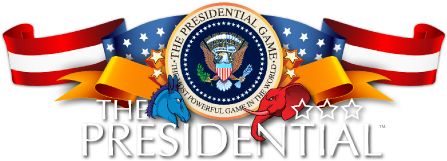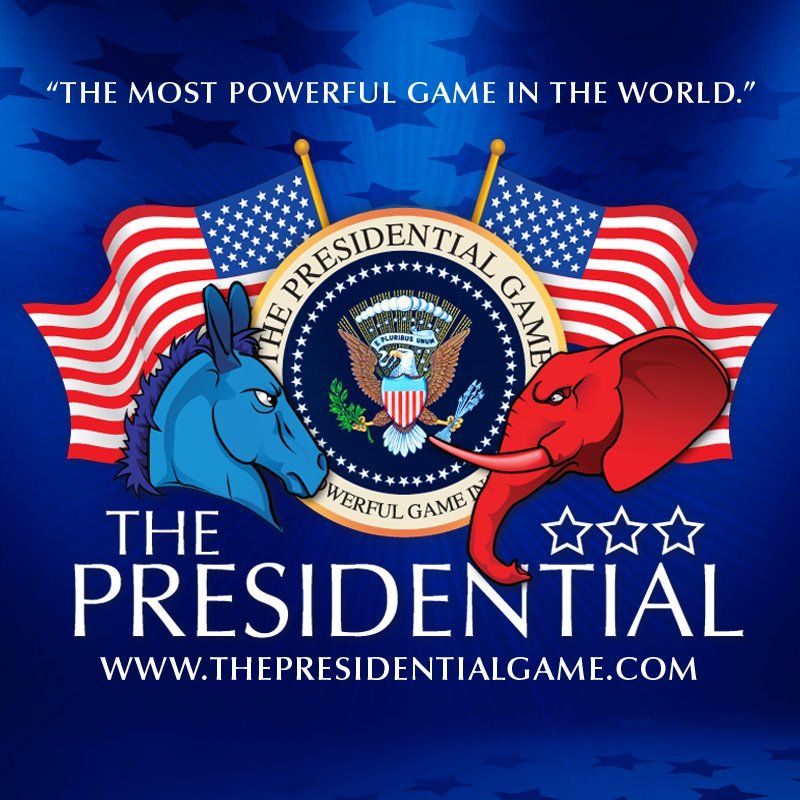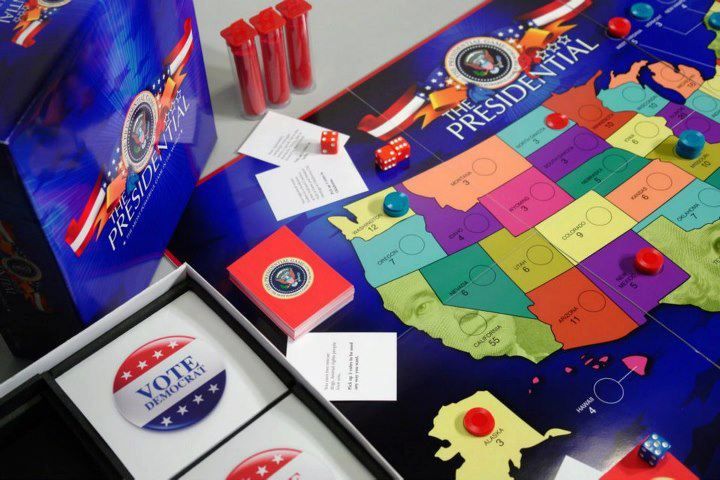
In August I was delighted when I learned I would have the opportunity to receive The Presidential Game to review for The Old Schoolhouse Review Crew. The folks at The Presidential Game were so kind to send me a free copy for purposes of this review!
I have been eternally fuzzy as to how Presidential elections work, and how the Electoral College works. After playing this game with my son, we both understand things a little bit better.
[I must say, though, that I am still a bit confused about one thing: if the Electoral College actually determines who becomes President, then why does it matter if the citizens actually vote on Election Day...? Anyway...]
[I must say, though, that I am still a bit confused about one thing: if the Electoral College actually determines who becomes President, then why does it matter if the citizens actually vote on Election Day...? Anyway...]
So if you are as confused as I was about the Electoral College, let me tell you a little bit about this game and how it helps the players understand a bit about how the politics of Presidential elections works in the United States.
The Presidential Game comes in a nice, sturdy, squarish box. It can be played by two individuals, or by two teams of as many individuals as you have at your table (as long as you can get them to play civilly! ;-)
We opened the box to find a nice, durable cardboard game board that unfolds to a large rectangle representing the United States of America. Nice sized, it was easy to play on, whether on the table or on the floor. There are two bags, one red (Republicans) and one blue (Democrats), with three dice per color and a stash of colored chips for keeping track of Electoral votes. There are Politic Cards, score sheets, and instructions. I expected a pencil or two as well, but none included. That's okay -- I've got plenty on hand.
From the start, let me tell you that our biggest obstacle to getting each game started is that someone, I mean SOMEONE, is going to have to play for the team of the opposing political party. In other households I imagine the obstacle might be to get opposing teams to play nicely!
Sad, but true, I waited too long to introduce this game to my son. He has picked a political party and refuses to play the team that is not "his" party, so I'm stuck with it. It's pretty funny, too, because we're not discussion political positions or anything, but comments regularly arise such as, "Texas is a Republican state! It will never be a Democratic state, so don't even try!" So it was fun seeing how much he had already figured out, and was actively figuring out, about which states are red, which are blue, which are swing, and what being "neutral" means in the game.
Sad, but true, I waited too long to introduce this game to my son. He has picked a political party and refuses to play the team that is not "his" party, so I'm stuck with it. It's pretty funny, too, because we're not discussion political positions or anything, but comments regularly arise such as, "Texas is a Republican state! It will never be a Democratic state, so don't even try!" So it was fun seeing how much he had already figured out, and was actively figuring out, about which states are red, which are blue, which are swing, and what being "neutral" means in the game.
To start the game, as I said, you begin by forming two teams, one of which will be Democrat and the other will be Republican. The teams roll one die each, and the highest score goes first.
Then the person whose turn it is, before rolling, declares whether Fundraising or Campaigning. Fundraising can be done in California, Texas, Florida or New York, and the state must be declared before rolling. The numbers on the three dice count as votes, and the team also gets to collect a Politic Card (which is usually, but not always, a good thing). Politic cards sometimes must be played immediately, but usually you can decide to play immediately or to wait.
If the person prefers to campaign, the person declares the state or states he/she will campaign in, and when the three numbers come up must assign one die to each state declared. No Politic Card given when campaigning.
This game is totally addicting, and (like a Presidential election), it is hard to accept and move on when it is time for the game to end.
There is a score-keeping tablet, but we kept the game moving so quickly that it was hard for us to remember to keep score. If you are doing the chips correctly, you can figure the score out at the end unless (picture a game of checkers) something happens and your stack of chips scatters. It becomes hard to reconstruct where the chips were supposed to be (but score keeping wouldn't tell you what state had how many chips either...)
When you read the rules card you will see, at the back of the card, instructions to get to the Electoral Webmap Calculator, and the password. As you play you keep an electronic tally of the position of each party on the map, just like in a real Presidential election. The first time I tallied the score, I wrote it down manually (because my computer wasn't handy), and this actually helped my son to understand that it was about who won the state and how many electoral votes the state gets, as opposed to it being about how many chips are on the state. There is a note at the back of the rules card mentioning the fact that in Nebraska and Maine the "winner-takes-all" rule does not apply, but that this game does not get into that issue of possible split electoral votes.
One thing that I am still confused about had to do with total votes per state. I was sort of assuming that if a state is marked that it carries only 3 or 4 electoral votes, then that is how many chips you put on the state, and that you don't put like 10 chips on a state that only gets 4 votes. But then I got a Political Card that said something like add six votes to Montana, a state that only gets only three electoral votes. This left me wondering if I had been playing that part of the game wrong, or if the card was a fluke. I don't know the answer.
Anyway, we love this game. My son loves this game, and he HATES so many things! It is a joy when he likes something that we review! He announced that this game should be mandatory to play every Presidential election. (He has no idea how few times that sounds like to me. Let's see, he is 13. Next election he will be 16, and after that he will be voting himself. ::sigh::)
The Presidential Game sells for $35 on the website, or you can order the game and the hat of your choice for $50 (Republican hat or Democrat hat).
Then the person whose turn it is, before rolling, declares whether Fundraising or Campaigning. Fundraising can be done in California, Texas, Florida or New York, and the state must be declared before rolling. The numbers on the three dice count as votes, and the team also gets to collect a Politic Card (which is usually, but not always, a good thing). Politic cards sometimes must be played immediately, but usually you can decide to play immediately or to wait.
If the person prefers to campaign, the person declares the state or states he/she will campaign in, and when the three numbers come up must assign one die to each state declared. No Politic Card given when campaigning.
We spent a lot of our rolls fund raising, trying to get and maintain the count in the four "heaviest" states (the ones with the largest electoral vote). It took my son awhile to understand how you win the game. It is not solely how many chips you have on the board; it is not solely how many states you have control over. The winner is based on the number of electoral votes at the end of the game. When you are battling over a state, you are trying to remove the opponent's chips and replace them with at least one of your own so that you control the state. For "valuable" states it becomes a huge fight, where it goes back, and forth, and back, and forth, etc. (The game does not come with the plastic tubes shown below to store the chips.)
This game is totally addicting, and (like a Presidential election), it is hard to accept and move on when it is time for the game to end.
There is a score-keeping tablet, but we kept the game moving so quickly that it was hard for us to remember to keep score. If you are doing the chips correctly, you can figure the score out at the end unless (picture a game of checkers) something happens and your stack of chips scatters. It becomes hard to reconstruct where the chips were supposed to be (but score keeping wouldn't tell you what state had how many chips either...)
When you read the rules card you will see, at the back of the card, instructions to get to the Electoral Webmap Calculator, and the password. As you play you keep an electronic tally of the position of each party on the map, just like in a real Presidential election. The first time I tallied the score, I wrote it down manually (because my computer wasn't handy), and this actually helped my son to understand that it was about who won the state and how many electoral votes the state gets, as opposed to it being about how many chips are on the state. There is a note at the back of the rules card mentioning the fact that in Nebraska and Maine the "winner-takes-all" rule does not apply, but that this game does not get into that issue of possible split electoral votes.
One thing that I am still confused about had to do with total votes per state. I was sort of assuming that if a state is marked that it carries only 3 or 4 electoral votes, then that is how many chips you put on the state, and that you don't put like 10 chips on a state that only gets 4 votes. But then I got a Political Card that said something like add six votes to Montana, a state that only gets only three electoral votes. This left me wondering if I had been playing that part of the game wrong, or if the card was a fluke. I don't know the answer.
Anyway, we love this game. My son loves this game, and he HATES so many things! It is a joy when he likes something that we review! He announced that this game should be mandatory to play every Presidential election. (He has no idea how few times that sounds like to me. Let's see, he is 13. Next election he will be 16, and after that he will be voting himself. ::sigh::)
The Presidential Game sells for $35 on the website, or you can order the game and the hat of your choice for $50 (Republican hat or Democrat hat).
- Was the game worth our time? Absolutely!
- Did it help us to learn about the Presidential election process? Absolutely!
- Is it worth the money? $35 is a lot to pay for a game, but it is a high quality game that is fun to play, educational, and will last a long time, so yes, it is worth the money.
- Ages: 11 and up
To read what other TOS Homeschool Review Crew members thought of The Presidential Game, click on the link below.







By 2016, The National Popular Vote bill could guarantee the Presidency to the candidate who receives the most popular votes in all 50 states (and DC).
ReplyDeleteEvery vote, everywhere, would be politically relevant and equal in presidential elections. No more distorting and divisive red and blue state maps. There would no longer be a handful of 'battleground' states where voters and policies are more important than those of the voters in 80% of the states that now are just 'spectators' and ignored after the conventions.
When the bill is enacted by states with a majority of the electoral votes– enough electoral votes to elect a President (270 of 538), all the electoral votes from the enacting states would be awarded to the presidential candidate who receives the most popular votes in all 50 states and DC.
The presidential election system that we have today was not designed, anticipated, or favored by the Founding Fathers but, instead, is the product of decades of evolutionary change precipitated by the emergence of political parties and enactment by 48 states of winner-take-all laws, not mentioned, much less endorsed, in the Constitution.
The bill uses the power given to each state by the Founding Fathers in the Constitution to change how they award their electoral votes for President. Historically, virtually all of the major changes in the method of electing the President, including ending the requirement that only men who owned substantial property could vote and 48 current state-by-state winner-take-all laws, have come about by state legislative action.
In Gallup polls since 1944, only about 20% of the public has supported the current system of awarding all of a state's electoral votes to the presidential candidate who receives the most votes in each separate state (with about 70% opposed and about 10% undecided). Support for a national popular vote is strong among Republicans, Democrats, and Independent voters, as well as every demographic group in virtually every state surveyed in recent polls in recent closely divided Battleground states: CO – 68%, FL – 78%, IA 75%, MI – 73%, MO – 70%, NH – 69%, NV – 72%, NM– 76%, NC – 74%, OH – 70%, PA – 78%, VA – 74%, and WI – 71%; in Small states (3 to 5 electoral votes): AK – 70%, DC – 76%, DE – 75%, ID – 77%, ME – 77%, MT – 72%, NE 74%, NH – 69%, NV – 72%, NM – 76%, OK – 81%, RI – 74%, SD – 71%, UT – 70%, VT – 75%, WV – 81%, and WY – 69%; in Southern and Border states: AR – 80%, KY- 80%, MS – 77%, MO – 70%, NC – 74%, OK – 81%, SC – 71%, TN – 83%, VA – 74%, and WV – 81%; and in other states polled: AZ – 67%, CA – 70%, CT – 74%, MA – 73%, MN – 75%, NY – 79%, OR – 76%, and WA – 77%. Americans believe that the candidate who receives the most votes should win.
The bill has passed 32 state legislative chambers in 21 states with 243 electoral votes. The bill has been enacted by 10 jurisdictions with 136 electoral votes – 50.4% of the 270 necessary to go into effect.
NationalPopularVote
Follow National Popular Vote on Facebook via NationalPopularVoteInc
Fascinating! Thank you so much! That is a change who's time has come. I am definitely for it. I'll go follow on Facebook now. Thanks.
Delete